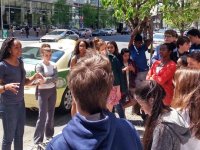The Creative Routine
Spontaneity can flourish to students’ advantage in a curriculum steeped in ritual and repetition that regularly introduces fresh new ideas and activities.
The other day I surprised my students. They had just completed an Op Ed assignment. Choosing an issue they felt passionate about, students used evidence to build an argument and propose change. We had spent more than a week on research, outlining, drafting, peer editing, and finally producing polished drafts to send to local publications.
That day I began the class period with some very ordinary announcements and reminders before shifting gears. "Today we are street speaking," I announced. "We're going to take this milk crate to Market Street and everyone will give a short speech about their Op Ed topic." I paused to let my description sink in. "You all can do this, and we will all be there to support each other and make it work." At this point, students couldn't restrain themselves. Conversations had erupted, and some students were calling out to me directly. I let the chaos and the exclamations of disbelief and fear take over for a minute before telling them more.
"This is going to feel scary. A big part of the challenge is overcoming your fear. You all know I would never ask you to do anything I am not willing to do myself. I'll give the first speech, and know that it is scary for me, too."
"Do we have to do it?" asked a student from the back of the room.
"I won't force you to do anything you absolutely feel you can't do. I do ask that everyone prepares and that everyone comes with us and offers support. Do your best. Right now you have five minutes to write key information from your paper on an index card before we head outside."
Routines and Spontaneity
Each year, students and teachers spend hundreds of hours together. The length of the school year challenges teachers to design curriculum and organize their classrooms in ways that maintain freshness and excitement, two essential elements of learning. Students and teachers both benefit from creative activities that deepen learning and connections.
Routines and rituals help students feel situated and secure. While these routines provide a necessary template of expectations and norms for students, equally important are spontaneous experiences and times when the plan shifts from the expected. Monotony serves no one, yet there is little logic for students in creating bizarre experiences that exist solely for the sake of shock value.
It is challenging to plan creative, new experiences while also enriching learning and building community, yet everyone benefits from more opportunities for spontaneity and joy. When designed well, learning can be playful and exciting while deepening understandings and creating meaning for students.
Below is a list of strategies that I will use to guide my planning for next school year as I focus on providing a range of learning experiences and working to avoid monotony.
1. Make Creativity the Routine
Being asked to create in complex, sophisticated ways is inherently stimulating and creative. The more that students can be the ones doing, the more we challenge them to go beyond what they already know. Of course, merely completing a task does not insure transformation or growth. As I wrote in an earlier post, classrooms are places where different forms of creativity should be nurtured and where limiting narratives should be challenged. Learning can be structured so that all students can discover avenues for creatively expressing themselves. Sir Ken Robinson reminds us how creativity is a universal skill that "draws from many powers that we all have by virtue of being human."
2. Plan Strategically
Any activity can become mundane if repeated without variation, feedback, or meaning. At the same time, introducing new activities solely for the sake of novelty can be shallow and meaningless. It's challenging to develop curriculum that harvests the power and depth of ritual and repetition while regularly introducing new and fresh ideas and activities. When I get stuck while designing curriculum, I remind myself of core beliefs that have led to meaningful experiences for my students in the past. One belief is that providing students with choice can lead to passion and engagement.
3. Create Community
Students need to feel both nurtured and supported before they are willing to take risks and challenge themselves to do something new. These feelings of security come from a connection with the teacher and from classroom cultures that engender safety and security. I repeatedly return to George Lakey's metaphor of creating a container and remind myself to work to create a compassionate classroom.
4. Use Model Texts and Constantly Share Ideas
It may be a blessing or a curse, but I cannot help traveling through the world with the eyes of a curriculum designer. When I hear an engaging radio piece, see a moving performance, or visit a thoughtful exhibit, I begin to think about what it would take for my students to create similar work. These model texts, drawn from many different sources and genres, inspire me and my students to create, think, and exist in new ways.
Remember to Imagine
The challenge of regularly providing fresh, creative experiences and opportunities for students is daunting. Drawing on the Right Side of the Brain explains that learning to draw is really about learning to see. Designing creative learning experiences is about developing awareness of potential and possibility.
In her book What It Is, the inspiring author Lynda Barry asks, "What makes us able to imagine?" One answer is creative, passionate teachers who work to create learning experiences that matter.
